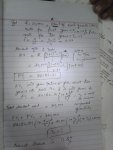naveed_786110
New member
- Joined
- May 10, 2015
- Messages
- 26
A firm will need Rs. 300,000/- at the end of 3 years to repay a loan. The firm decided that it would deposit Rs. 20,000 at the start of each quarter during these 3 years into an account. The account would yield 12% per annum compounded quarterly during the first year. What rate of interest should it earn in the remaining 2 years to accumulate enough amount in this account to pay the loan at the end of 3 years?
Here is how I just tried to solve it...but unable to solve the equation.... Kindly guide....Thanks

Here is how I just tried to solve it...but unable to solve the equation.... Kindly guide....Thanks

